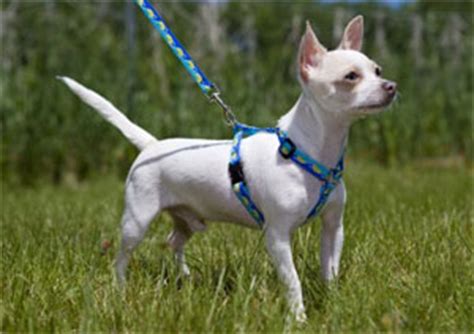Recommended Equipment

We strive to train your dog regardless of equipment choices. We do recommend the following equipment based on it's safety and comfort for the dog and handler.
Selecting a Leash
You’ll find a variety of leashes on the market, so this is usually just a personal choice. We ask that you stay away from slip leads and retractable leads when training. Choose a leash that is comfortable for you to hold and fits the height of your dog. In general, a 6 foot leash will work for most dogs.
Harness
A good harness is always recommended when walking your dog. We do not generally recommend “no pull’ harnesses unless you really just cannot manage your dog without one.
Why a harness?
- A harness is the safest option for most dogs. Even a flat collar when pulled will constrict oxygen and put pressure on the spine. Neither of these is healthy or comfortable to the dog.
- A harness reduces the sensation of pressure on the dog by spreading over a larger area. This may reduce pulling. Research has shown that dogs do not understand connectivity. They do not know what has “got them”. So when you pull back on the leash, your dog will likely pull back with the same intensity. This means he will pull more on a collar than on a leash, increasing the chances of injury and making him harder to walk.
Treat Pouch
Your treat pouch needs to be big enough to hold sufficient treats for class. It should be easy to reach into your pouch for treats. A pocket is not recommended as the treats can stain. A plastic bag is also not recommended as the sound of the bag can interfere with training.
Here are some that your trainer recommends:
- Petsafe Treat pouch – we like this one for the hinge. It makes getting to the treats so easy, and when your dog tries to stick his nose in the pouch you can snap it closed to keep him out. You can purchase this pouch on Amazon here: https://a.co/d/ezrVhYq
- Two Hounds Design treat pouch (available in the School for Dogs lobby).
- If you use fresh food as treats there are a variety of silicone treat pouches available that are easy to wash after use.
Treats
Treats should be small, soft, and easy to handle. You will do better with something that is soft because it will not crumble on the floor and slow your dog down while he vacuums up the pieces. You can choose commercial treats or make your own. You can also use “human” food. Pieces of chicken, low fat cheese, or even fruit will work. Let your dog decide what’s worth working for.
Settle Mat
There are a number of things to consider when selecting a settle mat.
- Will the mat slide on a slick floor when your dog steps on it? It’s always best to select a mat with a rubber backing that will not move out from under your dog’s feet. Sliding could scare your dog and cause him/her to create negative associations with it.
- Is that mat portable? You may decide that you need your mat for more than class and home. Something you can roll or fold up and take with you is preferred.
- Is it washable? These are dogs after all.
- Am I willing to live with it? You may want to keep the mat around for a while as dogs don’t generalize very well, so get something you don’t mind living with.
- Is it something your dog might want to chew? A mat that lays very flat on the floor is harder for puppies to get a hold of. And don’t use fabrics that your particular dog likes to chew on.
- Can I put it away? Remeber: we will keep our settle mat put away until this cue is trained so they don’t go to the mat without being rewarded. To start the mat needs to be 100% rewarding!
Clicker
You’ll be provided with a clicker at your first class. You may need to put it in your pocket if your dog is sensitive to the noise. If you have trouble with the box clicker there are other varieties that have buttons that are sometimes easier to use for people with arthritis and other conditions. Ask your trainer to show you hers.
Your trainer recommends you use a lanyard to hang the clicker around your wrist or neck.
On rare occasions dogs do not like the sound of the clicker. If your dog shows signs that he/she doesn’t like the clicker, we will find an alternative.
